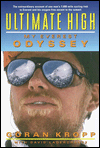 The Basics: Harry Potter and the Deathly Hallows, J.K. Rowling, 2007, 607 pages, hardcover
The Basics: Harry Potter and the Deathly Hallows, J.K. Rowling, 2007, 607 pages, hardcoverHow I found it: Like everyone else, I preordered it from Chapters and waited for my Canada Post special Saturday delivery last weekend (mine arrived at 11am). I have been a fan of the Harry Potter series since the 3rd book came out and I realized it wasn't just for kids.
What's it about?: This is the culmination of the Harry Potter series where he finally faces off against Voldemort. Without giving away too many plot points, the story revolves around Harry, Ron and Hermione travelling around and camping, trying to find clues towards a mysterious quest that Dumbledore gave them at the end of the last book, and trying to avoid Voldemort's Death Eaters. There are several battles, including a grand finale battle at the end.
Did I like it?: As with all the Harry Potter books, I liked this one. However, at 607 pages, I found that it did drag a bit at times, and the plot was slow moving, especially during all the camping scenes. It does have a good ending that was a surprise to me, despite all the rumours flying around about it. I also enjoyed the epilogue as it provided a great parallel to the whole series.
Will you like it?: If you've read the other Harry Potter books, you are pretty much obligated to read this one to find out what the final outcome will be. Plus, it's just as good as most of the other Potter books. The books have grown up with their readers, and this is more teen fiction than children's lit now, which will appeal to the older reader. If you haven't read the Potter books, don't read this one - start at book one, work your way through, and say goodbye to your free time as you get sucked in.
But don't take my word for it: A huge amount of Harry Potter background and some reader reviews (some with plot spoilers) from Amazon.ca, a review from a north London blogger, one from the UK's Telegraph and the Guardian, and the wikipedia entry (with plot spoilers). These are just a few of the thousands of things written about the release of this book. It was a huge media event - do some googling if you need more.

